Content created: 2019-09-26
Open anthropology dictionary in new window.
Open world map in new window.
Ancient Greece
A Brief Introduction for College Students (5)
D.K. Jordan
Ancient Greece: Appendix:
The Aegean World
We are used to thinking of countries as land masses crossed by roads (or at least paths or trails). Modern countries are mostly like that, as were ancient lands with few rivers. (Mongolia and Persia were like that. So were Anatolia and Canaan and the Yucatan Peninsula.)
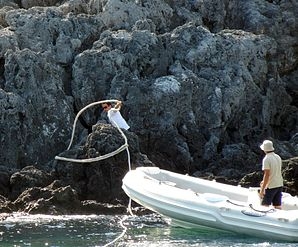
Tying up a Boat at Hamam Bay, Island of Rhodes. Most of Greece was difficult terrain for road-building.
Or we are used to thinking of countries as land masses with networks of rivers and canals attracting dense settlement but with much less settlement where rivers were absent. (China and India were like that. So were Egypt and Mesopotamia.)
But Greece had neither significant rivers nor significant networks of trails and roads. It was a hilly, rocky place, depending upon the Mediterranean as the main way to travel, and it is hardly surprising that Greeks frequently migrated to adjacent lands, including islands. For Greeks, the sea was perceived as uniting more than separating the many states of the significant (i.e., Hellenophone [=Greek-speaking]) world. This means that the coasts on the Turkish side of the Aegean were home to Greeks who were just as Greek as those on the West side. (Click here to learn why ancient Greeks might have disagreed.)
Famous Greeks did not by any means all come from “the hand” of the Peloponnese, or from Athens just to the northeast of it, (although Athens was clearly the "Big Apple" of the system).(Click me.)
It is a useful corrective to note the very many significant figures of Greek antiquity who hailed instead from the east side of the Aegean. Few readers will have heard of all of them, but most will have heard of some of them, and may be surprised that they came from Turkey and its adjacent islands.
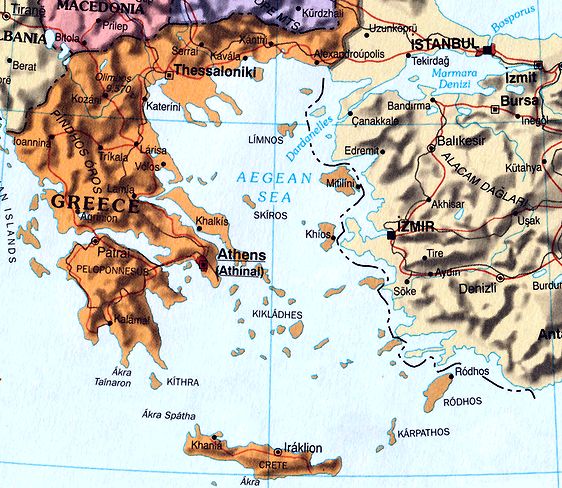
The rest of this page is merely examples, which means you [think you] can ignore them. In any case, do NOT spend time memorizing them!
(Of course, if you do keep reading they are pretty interesting, and they can provide an excuse to play with Google Earth instead of doing math homework, and the statue of Artemis is pretty remarkable —and may or may not count as obscene— and it is amusing that the American national anthem both derives from a silly drinking song/hymn to the ghost of the poet Anacreon in his quality as god of drunken orgies and also is arranged here for convenient dorm-suite sing-alongs …)
There are some very simple maps linked to The Iliad Guide map link, but for present purposes the map above with more detail will be more useful. A small copy of it is reproduced now and again down the page so you can use your browser to examine it more closely any time you wish.
Since the point of all this is merely to stress that what are today the Aegean islands and the Turkish coast were very much ancient Greece, just as what is today mainland Greece was, each person in this list gets only a single, heavily rounded date. Assume each was born, lived, and died in a single year and don't worry about it.)
- Ionia (Central Coast & Adjacent Islands)

- HOMER [800 or 750 BC], author of the Iliad and the Odyssey, regarded by all normal later Greeks and Romans as the most gifted writer who ever lived (although some modern scholars argue that he probably didn't exist). He lived possibly in Smyrna, possibly on the island of Chios.
- THALES [600 BC] and his student ANAXIMANDER, founders of what would become science, admired by Aristotle
- XENOPHANES [500 BC], the philosopher who argued that men created gods rather than vice versa. (By the time Socrates came along, you could get in big trouble for a view like that. In Kansas you still can.)
- HERACLITUS [500 BC], the philosopher who argued that you couldn’t step in the same river twice because the world is constantly changing. Some people like to say that he was the first evolutionist in the Western tradition.
His comment that "All entities come to be in accordance with this logos (which means both "principle" and "word") continues to bother people, especially New Age people; it is just too similar to all things being in accordance with the Chinese dào or "way," which also has a seondary meaning as "to say." Can speech and principles governing the universe really be that obviously linked?. He is also reputed to have said, "The road up and the road down are one and the same." That bothers people too, but only some people and for different reasons.
- The Island of Lesbos
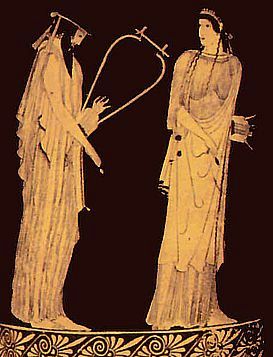
Alcaeus Singing to Sappho, Who Seems More Startled Than Impressed (Vase Painting, Vth Century BC)
- PITTACUS [600 BC], the pre-Classical ethicist, one of the "seven sages" of Greece. (Click me.)
- SAPPHO [600 BC], the famous female poet, often believed to be a lesbian (although some say she had a husband and daughter), hence the modern word "lesbian," derived from the name of the island. (Click me.)
- ALCAEUS, her less famous poetic friend. Alcaeus penned the lines, “Virginal black-haired Sappho of the sweet smile, my tongue wants to speak to you, but it is restrained by shame.” (He was also the head of a secret revolutionary society, which did not turn out well for him.)
- The Island of Aeolus (just south of Lesbos)
- HESIOD [700 BC], Homer's contemporary, who wrote on a range of subjects, including quite mundane ones but also on mythology and even the Trojan war
Return to top.

- Island Caria (Islands South of Ionia)
- The Island of Kos
- HIPPOCRATES [400 BC], physician —the Hippocratic oath man. He was from a family of physicians living on the island of Kos, where they claimed to be descended from the medicine god Asclepius, whose principal shrine had been there from remote antiquity. (A selection of readings attributed to him is available on this web site —link. He's impressive.)
- The Island of Rhodes
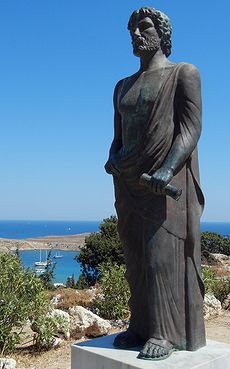
Modern Statue of Cleobulus
- CLEOBULUS [500 BC], a poet who introduced Egyptian philosophy to Greece and contributed to the Greek stereotype of Egypt as a place of infinite wisdom. (This made him popular with ex-pat Egyptians, one assumes.)
- POSEIDONIUS of Apamea [100 BC], Stoic philosopher and mathematician born in Apamea in Syria. He moved to Rhodes because it was where the action was, so he is also Poseidonius of Rhodes.
- The Island of Patmos
- ST. JOHN of Patmos, author of the Book of Revelation, the last book of the Christian Bible.
- The Island of Samos
- ANACREON [500 BC], the famous poet of "wine, women, and song."
Anacreon's songs were remarkable enough that two and a half millennia later the raucous British drinking song of about 1771 addressed to him provided the tune to the American national anthem. It began with the words “To Anacreon in Heaven … .”
- Lyrics (For the curious or those prone to bursting into song.)
- YouTube File 1 tenor John Townley with picture of a fox hunt
- YouTube File 2 barber-shop quartet with picture of a flag
- YouTube File 3 tenor Roao Rocha, with silly picture
- YouTube File 4 tenor Roao Rocha, with different silly picture
- YouTube File 5 excitable Georgia Tech men's glee club (possibly drunk, but clearly having way too much fun)
(Tired of studying tonight? How many more sound files of this song can you find on the Internet? Just a thought.)
- PYTHAGORAS [500 BC], mathematician —he of the theorem. (In contrast to Anacreon, it would be distinctly geeky to compose a drinking song to Pythagoras. Possible, but geeky. Very geeky.)
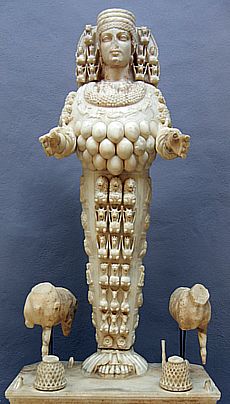
Artemis of Ephesus, Goddess of Fertility
Ephesus was a major cult center for Artemis, the sister of Apollo and a goddess of hunting and wild animals. You may recall that it was she who, some say, saved Iphigenia from being sacrificed … if she did. (BTW, the answer to your question is yes, that IS what they are, despite the efforts of generations of high school Latin teachers to deny it. I've been there and I looked very closely. There is no question about it. Furthermore, this is not the only statue in Ephesus that presents her this way.)
- Coastal & Inland Caria (Region South of Ionia)
- The Town of Ephesus
- MARY, the Mother of Jesus, said to have died in Ephesus
- ST. JOHN the Evangelist, who is said to have painted her picture there.
- The Town of Miletus
- THALES [600 BC], philosopher and mathematician. He was the founder of what became known as the "Ionian School" of Greek philosophy. He sought a single elementary particle —an atom— as the basis for the whole physical world. (His motto "Know yourself!" was eventually engraved over the oracle of Apollo at Delphi.)
- THEMISTOCLES [500BC], one of the ablest generals of the ancient world was born in Athens, which he saved from Persian invasions, but whence he was later banned by the fickle populace. He moved to Miletus, where he was made the Persian governor. (Life has its little ironies.)
- BIAS of Priene (just north of Miletus) [550 BC], the founder of a school of philosophy based on the proposition that “most men are bad.” (It is a temptation to imagine that the word "bias" comes from him, but this is not known.)

- HIPPODAMUS of Miletus [550 BC], called the first urban planner. Countless later cities, from ancient Ephesus and Piraeus to modern Salt Lake City, Paris, and Washington all owe features of their layout to Hippodamus. Thomas Jefferson explicitly modeled the layout of the University of Virginia on "Hippodamian" principles. (What are they?)
- ISIDORE of Miletus [AD 562] redesigned the dome of Hagia Sophia in whatis today Istanbul.
- The Town of Halicarnassus (Modern Bodrum)
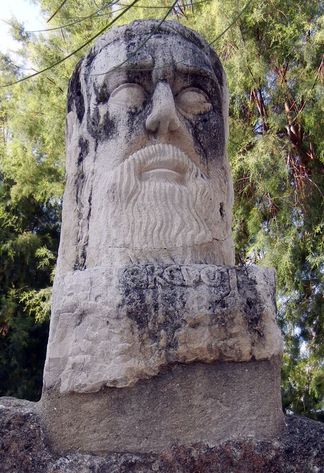
Modern Bust of Herodotus
He was probably more fun at parties than the sculptor makes him look.
- HERODOTUS [450 BC], the "father of history." Herodotus was almost certainly the scion of a wealthy family. He travelled widely and wrote a phenomenal history of the Persian war based not only on texts but on substantial travel and interviewing. (He could almost as well be called the "father of cultural anthropology" or the "father of journalism.") He was much criticized by the other major Greek historian, Thucydides [300 BC], who complained that Herodotus' writings were much too gossipy and … um … interesting.
(I had a critic say something similar of one of my books once. Since he was, like Thucydides, a known churl, I persuaded the publisher to quote his comment on the dust jacket of the second edition. It's hard to say how many additional books it sold.) On the other hand, Thucydides, churlish or not, was a font of wise sayings. Try a Wikiquote search and you will find one for every occasion.
- DIONYSIUS of Halicarnassus [30 BC], grammarian and writing instructor. As the Romans were taking over the world, Dionysius of Halicarnassus wrote eloquently about why they were more lovable than they seemed, although in fact most of them weren't lovable at all, especially if they happened to be taking you over. But it made him a favorite with various influential Romans, to whom he tried to teach proper Greek. He devoted much of his life to the Sisyphean mission of editing other people's texts to make the prose natural and eloquent rather than halting and insipid. (Think college writing teacher.)

- ARTEMISIA I [450 BC], the world’s first (known) female admiral.
Caria was allied with Persia against Athens, and Artemisia outdid her Persian colleagues in sinking Athenian ships. Athens offered 10,000 drachmas to anybody who could drag her in dead or alive. She was rather proud of that. (Nobody did. She was proud of that too.)
- ARTEMISIA II [350 BC], wife of a provincial lord named Mausoleus and designer of his monumental tomb. Not only was it one of the seven wonders of the ancient world, it gave us the modern word "mausoleum."
- The Town of Aphrodisias
- XENOCRATES of Aphrodesias [AD 50], a physician and the author of pharmaceutical works. One of his works, On Useful Things from Living Beings described pharmaceutical uses for urine, dung, human brains and organs, &c. Ancient physicians condemned these discoveries for being disgusting, but they won him a place in the history of pharmacy. (We get the term "aphrodisiac" from this source. His recipe is probably on the Internet somewhere. Don't Google it.)
- Mythical Figures in Caria (which seems to generate love stories)
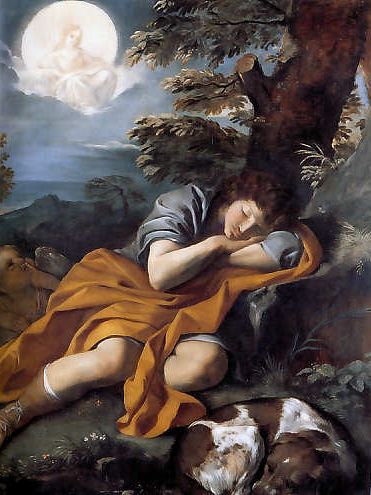
Endymion and Dog, Observed by Selene Seated on the Moon Over Lake Bafa
- ENDYMION a handsome shepherd fathered by Zeus. (Zeus went about fathering a good deal, and his kids tended to be easy on the eyes. It's a divinity thing.) It is said that Selene, a goddess associated with the moon, fell in love with Endymion at first sight as he slept with his dog beside his flocks, and she wheedled Zeus into granting him eternal youth so that he would never change. However, since she particularly loved looking at him as he slept, and perhaps fearing that he might have his own ideas on awakening, she also had Zeus grant him eternal sleep. And there he slumbers to this day (with his dog, who got hit with the same spells) in a cave in the hills above lake Bafa, near Miletus. (Click me.) (Legend does not record whether the dog was also handsome. This picture is not encouraging.)

- BYBLIS fell in love with his twin brother KAUNOS in Miletus and made the mistake of saying so, with the result that Kaunos ran away and founded the city of Caunus (which became an important shrine to Apollo). Byblis, heartbroken at the rejection, cried until his tears formed the Dalyan (Kalbis) River near Marmaris.
- And so on.

Diogenes Failing to Find an Honest Man (even using a lamp)
- Greeks Further North
-
XENOCRATES of Chalcedon (near Istanbul) [350 BC], a companion of Aristotle and major ethicist. (His works have been lost, as have those of most of the people mentioned on this page.)
- DIOGENES of Sinope [300 BC], the Cynic philosopher who couldn’t find an honest man— from the Black Sea coast of Turkey)
- PANSANIAS of Magnesia (south of Troy) [AD 150], author of the first deliberate travel guide to the Greek world.
Picture Sources:
- The picture of Alcaeus singing to Sappho is from a Vth-century BC vase of unknown origin. (It is in the Munich National Collection of Antiquities & Sculptures in Munich.)
- The modern bronze statue of Cleobulus is from the Lindos archaeological site on the island of Rhodes.
- The statue of Artemis is from the Ephesus museum. It dates to about AD 150.
- The modern statue of Herodotus stands before the archaeological museum in Bodrum, Turkey.
- The painting of Endymion by Pier Francesco Mola, dates from about 1660 and is the Musei Capitolini, Rome.
- The painting of Diogenes was found on the Internet and is still unidentified.
Return to top.
Go to
1. Early History,
2. Later History,
3. Philosophers.
Go to
4. Appendix: Values,
5. Appendix: Geography (this page).
Background Design: Linear B Script, Greece, about 1200 BC
(based on a tablet from Pylos)













